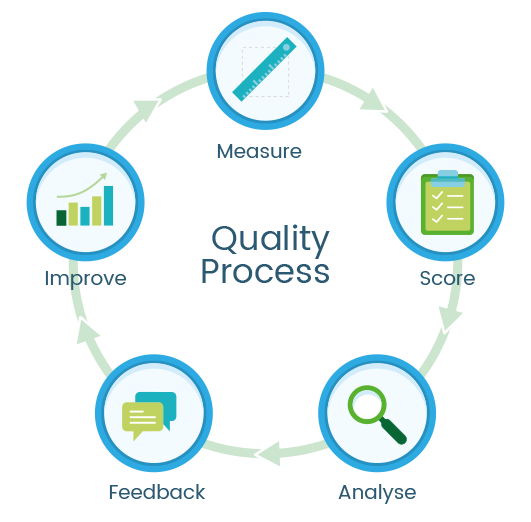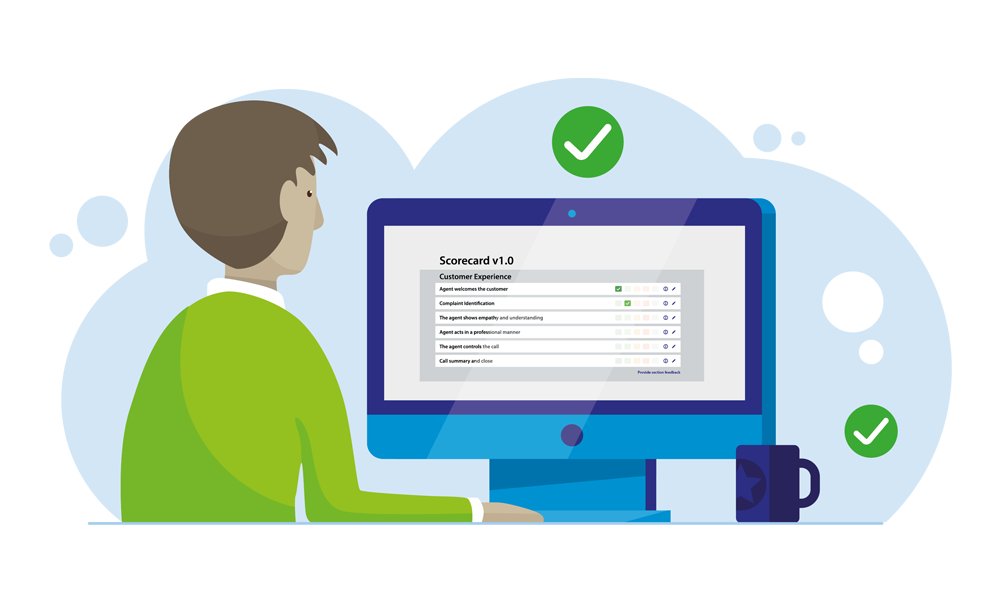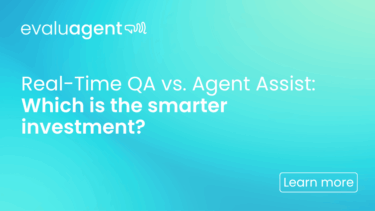A Quality Score is a great metric, yes, but QA can go way beyond just presenting a score to your business. The outcome of quality assurance, like any measurement inside your customer service teams, should be to improve customer satisfaction.
Within our guide to Getting Started with QA, there’s a number of quality assurance themes but perhaps none as important as making the most of your QA process. There are a number of benefits to be realised from your quality assurance process but it is only when they are all combined that maximum benefit can be obtained.

As a reminder, the QA process consists of:
- Measure
- Score
- Analyse
- Feedback
- Improve
If we look at each stage of the process in more detail and determine how it could be delivered, we can start to identify the best practices that will deliver the greatest returns.
Measure
This immediately raises a number of questions;
- How many contacts should we measure?
- What type of contacts should we measure?
- When should we do the measurement?
- What should we be measuring?
Firstly, it’s important you understand the focus of the measurement. If it’s to produce a score for a KPI then it’s relatively straightforward to select a sample at the same time for each reporting period. However, if it’s to extract performance information for an individual then it may be necessary to be more selective. Focus a sample around a particular contact type or channel or time of day.
The most common question asked by those people measuring is – how many? Well as discussed, this varies depending upon circumstances and the role of the assessor. If you’re a quality assessor then you’d be able to (and expected to) measure a lot more interactions than perhaps a team manager who has other responsibilities. However, when looking at maximising the benefits – statistically the outputs will be more accurate with a higher sample rate.
Historically there was a challenge in storing lots of telephone calls for a long period of time. Now, the price of storage and the ease of extracting specific contacts is so much easier that for most organisations it is prudent to store more interactions and use them when required.The timing of measurement is also very important. If monthly measures are taken and then time is spent scoring and then analysing, it could be a few weeks before feedback is provided or a meaningful score is available as a KPI. This is too long and means that any data reported is no longer relevant and is out of date.

Tip. Ensure any quality assessments are done in a timely manner to ensure data, scores, and KPI’s are still relevant.
Score
It’s important to treat each interaction in isolation but operate within a scoring framework.
There are some obvious areas for scoring where there are simple binary scores; yes, they did provide their name or no they didn’t. There are other more subjective areas such as how engaging the agent was. These are more difficult to score but there are two things that can make it easier.
- Firstly, calibrate scores by working with other Assessors to ensure that everybody is working to the same guidelines and expectations.
- Secondly, produce a summary of what the score means and provide some examples. It is necessary to define the difference between scoring 7 or 8.
If you want some help building a scorecard, check out this scorecard template. Scoring is difficult in isolation especially with an inherent knowledge of the person being assessed and the environment that they are operating in. The skill is in the ability to be objective when scoring more variable areas. Do not think about the person being assessed, think about the customer interaction.
Tip. When scoring, focus on assessing the customer interaction rather than the person handling the contact. Be objective.
Analyse
Once measurement and scoring have been completed, the next stage is fundamental in maximising the benefit; analysing the scores. Timeliness has already been mentioned and this reinforces the importance of it. In order to avoid negative trends, it’s essential that the data is as current as possible.The analysis should look at various components. Trend analysis should be undertaken for each agent, team, and then the whole service. A trend analysis also needs to be undertaken for each question. A number of questions need to be asked:
- What are the trends relating to an individual QA Assessor?
- Are there areas where agents always score well/poorly?
- What changes (if any) have there been in the scores since the last analysis?
- Why are some scores better than others?
- Are there certain areas in decline?
Feedback
The feedback stage is often talked about and is possibly the most important and most difficult part of the process. Being able to use the analysed scores as a way of providing agent performance feedback is a skill. It is not just about giving the scores or even the analysis of the scores, it is about being able to use that data and the subsequent conversation to motivate and encourage the agent.
Analysis of performance can encourage discussion about a much wider issue than the performance itself. It can highlight when people have performed consistently well as well as those that are struggling. It can open up communication of work and non-work-related problems that are impacting performance which can start additional support if required.
Recruitment and training of new starters are time consuming exercises. Using the QA process effectively can contribute to lower attrition rates and increase efficiency.
Tip. Invest in training Assessors to provide good feedback to their teams.
Feedback does not just relate to individuals though. If the quality score is important then a team score should be regularly published and shared with the team to show how they are performing collectively.
Improve
The final stage of the process is to improve as a result of the information obtained. This may be in the form of additional training in areas that are not scoring well or it may be in changing a process that the team are all struggling with.
The Analysis stage will identify the key areas of opportunity for improvement. If there are negative trends then these should be investigated to determine if they are individual or cultural trends. Is there a particular behaviour developing across the team? Can this be corrected before it reaches the whole service?
Providing feedback of improvements to the team will also encourage greater feedback from individuals where they can see opportunities for greater improvement.

So hopefully it can be seen that to maximise the benefits it is important to look at all areas of the process and ensure that they are joined up. Invest in the process and there will be a return.
Looking to introduce QA? Check out our guide, Quality Assurance: Getting started with QA. Want to chat more? Get in touch with us.




